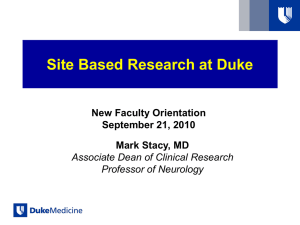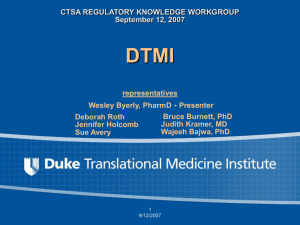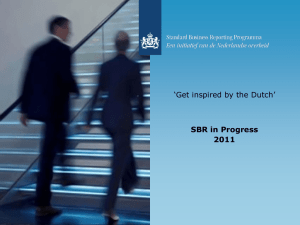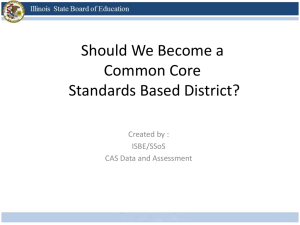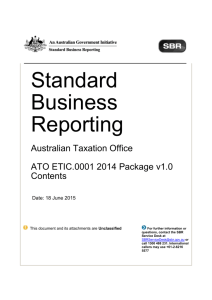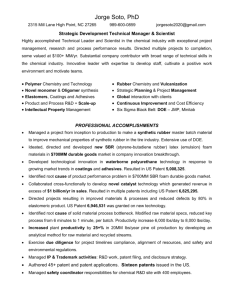Minutes of the Meeting
advertisement
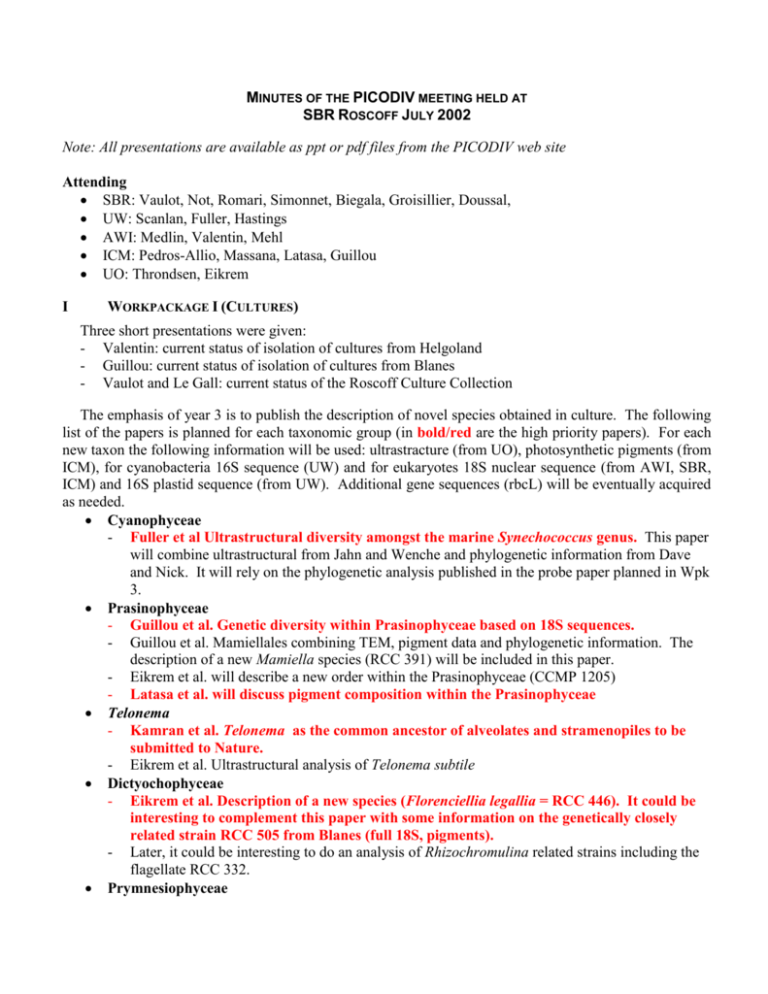
MINUTES OF THE PICODIV MEETING HELD AT SBR ROSCOFF JULY 2002 Note: All presentations are available as ppt or pdf files from the PICODIV web site Attending SBR: Vaulot, Not, Romari, Simonnet, Biegala, Groisillier, Doussal, UW: Scanlan, Fuller, Hastings AWI: Medlin, Valentin, Mehl ICM: Pedros-Allio, Massana, Latasa, Guillou UO: Throndsen, Eikrem I WORKPACKAGE I (CULTURES) Three short presentations were given: - Valentin: current status of isolation of cultures from Helgoland - Guillou: current status of isolation of cultures from Blanes - Vaulot and Le Gall: current status of the Roscoff Culture Collection The emphasis of year 3 is to publish the description of novel species obtained in culture. The following list of the papers is planned for each taxonomic group (in bold/red are the high priority papers). For each new taxon the following information will be used: ultrastracture (from UO), photosynthetic pigments (from ICM), for cyanobacteria 16S sequence (UW) and for eukaryotes 18S nuclear sequence (from AWI, SBR, ICM) and 16S plastid sequence (from UW). Additional gene sequences (rbcL) will be eventually acquired as needed. Cyanophyceae - Fuller et al Ultrastructural diversity amongst the marine Synechococcus genus. This paper will combine ultrastructural from Jahn and Wenche and phylogenetic information from Dave and Nick. It will rely on the phylogenetic analysis published in the probe paper planned in Wpk 3. Prasinophyceae - Guillou et al. Genetic diversity within Prasinophyceae based on 18S sequences. - Guillou et al. Mamiellales combining TEM, pigment data and phylogenetic information. The description of a new Mamiella species (RCC 391) will be included in this paper. - Eikrem et al. will describe a new order within the Prasinophyceae (CCMP 1205) - Latasa et al. will discuss pigment composition within the Prasinophyceae Telonema - Kamran et al. Telonema as the common ancestor of alveolates and stramenopiles to be submitted to Nature. - Eikrem et al. Ultrastructural analysis of Telonema subtile Dictyochophyceae - Eikrem et al. Description of a new species (Florenciellia legallia = RCC 446). It could be interesting to complement this paper with some information on the genetically closely related strain RCC 505 from Blanes (full 18S, pigments). - Later, it could be interesting to do an analysis of Rhizochromulina related strains including the flagellate RCC 332. Prymnesiophyceae II Chrysochromulina (lower priority): Two potentially novel species are present in the RCC (RCC 390 and 400). More data need to be acquired (full sequences, pigments, details of scales). Chrorarachniophyceae - RCC 365 is a small flagellate that could be interesting to study. However until now it has not been possible to fix (full sequence will be obtained). - RCC 337 is a larger strain that is probably related to Chlorarachnion (full sequence will be obtained) Other taxonomic groups (lower priorities) - Dinophyceae: Exuviella like (RCC 303). This strain could correspond to Prororentrum nux recently described by Zingone in Phycologia - Eustigmatophyceae: Nannochloropsis (RCC 357 + Blanes strains). A new species has been described that could correspond to one of this strain. - Trebouxiophyceae: Nannochloris like. Many strains. - Chlorophyceae: Chlamydomonas like (two strains RCC 300 and 537) WORKPACKAGE II (CLONE LIBRARIES) Three short presentations were given: - Valentin: Analysis of sequences from a novel group closely related to the Rhodophyta - Guillou: Analysis of natural populations (fractionated and following enrichment) by DGGE - Groisillier: Strategy planned for the analysis of the novel alveolate groups. Dave pointed some of the issue that still remain There are still some problems with the cyanobacteria/plastid clone libraries since the existing primers do not appear to be really specific. This could be solved by using a 23S rRNA primer It could be interesting to construct other plastid/cyano libraries - Low oxygen zone off Chile - Arabian Gulf Some eukaryotic clone libraries planned from cruises of opportunity (MINOS, PROSOPE, Red Sea) remain to be constructed after samples have been prescreened by DGGE. Should we probe clone libraries from underrepresented groups (e.g. Haptophytes)? This is not a priority at this point. The emphasis of year 3 will be on the analysis of clone libraries from coastal sites and the preparation of papers (some are already in advanced stage). Moreover, we will now obtain full sequences for some of the most interesting groups. We decided that the study of each targeted group will be coordinated by one person who will then request full length sequences from the other partners as needed. Telonema --> Kamran (Oslo) Red group --> Klaus (AWI) Prasinophyceae --> Laure (Barcelona) Stramenopiles --> Ramon (Barcelona) Alveolates --> Agnès (Roscoff) Daniel also mentionned that he communicated OLIPAC and Roscoff sequences from two taxonomic groups (one uncultivated, apparently related to Acanthareans, and Cercozoa) to David Moreira for phylogenetic analysis. III WORKPACKAGE III (PROBES) One short presentation was given: - Doussal: Validation of probes for a novel group closely related to the Rhodophyta The status of the different probes is as follows Validated and used on field samples - Synechococcus (UW): paper in preparation - Stramenopiles (ICM): paper submitted - Prasinophyceae (SBR): paper in preparation - Cryptophyceae Crypt13 (SBR): validated (description will be included in time series paper) In progress - Hetero01 (AWI): signal and specificity problems - Env Rhodophyta-like (SBR): almost validated - Prymnesiophytes (AWI): in progress, FISH-TSA remains to be done - Cryptophytes (AWI): no testing planned in immediate future To be designed - Alveolates (SBR): will be designed late 2002 - Eustigmatophytes , Dictyochophytes (SBR): already designed, not tested - Telonema, Chlorarachniophytes, Chrysophyceae: nothing planned yet IV WORKPACKAGE IV (PROBE MEASUREMENT) The progress and plans for the different technologies were reviewed. DNA chips (AWI): Linda please fill in with your current plans FISH-TSA with flow cytometry (SBR). Although a protocol for cell concentration and FISH hybridization compatible with flow cytometry has been worked out, some discrepancies between microscopy and cytometry counts have appeared for non-Chlorophyta taxonomical groups. Attempt to solve this problem is currently under way. Also questions emerge concerning how applicable this approach will be. The most interesting prospect appear to couple FISH-TSA with sorting to enrich samples in specific taxonomic groups and perform molecular analyses such as clone libraries on the sorted material. Quantitative PCR (SBR). Progress has been done in the first semester of 2002 (DEA Bastien Simonnet). However still a lot of issues remain to be solved. - Although we used mainly the SYBR approach, the use of Taqman probes should be tested further. - Primer should optimized with two major criteria • amplification efficiency: it should be as close as possible to 100% • specificity: non-target groups should not be amplified - Although initially we had planned to make primers for all eukaryotic taxonomic groups, we have now narrowed our targets: • General eukaryotic primers. It is critical to get good data for the total eukaryotic population and several combination of primers should probably used together • Prasinophyceae. The probes - Normalization of data: we plan to use cloned DNA to determine gene copy number - Finally we will perform some tests on: • Mixed populations • Natural samples V WORKPACKAGE V (TIME SERIES) Two short presentations were given: - Latasa: Improvements of the CHEMTAX running conditions - Eikrem: TEM of natural samples: results and problems The tables below summarize the measurements that will be done on the samples from the different seasonal series, the exchange of samples between partners and the minimum set of probes to be applied (click here to download the corresponding Excel file). It was emphasized that we should proceed as quickly as possible with the exchange of samples, in particular for DNA samples. We agreed on a deadline on Sept 15, 2002 to proceed with sample exchange. Method Population Flow cytometry Flow cytometry Phytoplankton counts Pigments HPLC DGGE SSCP Dot blots FISH picoplankton bacteria FISH FISH FISH FISH QPCR DNA chips General probes Prasinophytes Red group Stramenopiles General set General probes cyanos cyanos Roscoff 2000-2001 2001-2002 Test period 24/07/00 05/03/01 to 16/02/01 to 1/10/02 SBR SBR SBR SBR SBR SBR Mikel Mikel Ramon Klaus Dave Dave Fabrice Fabrice Fabrice SBR Fabrice Fabrice Fabrice Ramon SBR AWI Helgoland 2001-2002 Blanes 2001-2002 SBR SBR Helgoland Mikel Ramon Klaus Dave Dave ICM ICM Renate Mikel Ramon Klaus Dave Dave Fabrice Fabrice Fabrice Fabrice Ramon SBR AWI Ramon SBR AWI Remarks FISH on selected samples from the Blanes site for Prochlorococcus since these FISH probes are already developed. FISH Syn probes for use with Roscoff and Helgoland samples will likely be outside the PICODIV timeframe See Excel sheet in same file Corresponds to samples already processed Sending lab Receiving lab ---> Roscoff Roscoff Warwick Syn cultures Sequences Bremerhaven FISH euks DNA QPCR Sample flow cyto Cultures Sequences FISH euks DNA QPCR Cultures Sequences Barcelona Warwick FISH proks DNA for probes Bremerhaven DNA SSCP DNA Microarray FISH proks DNA for probes FISH proks DNA for probes DNA SSCP DNA Microarray Barcelona FISH strameno DNA DGGE Samples HPLC Cultures HPLC Oslo Samples TEM Culture TEM FISH strameno DNA DGGE Samples HPLC Cultures HPLC Samples TEM Culture TEM Samples TEM Culture TEM Minimum set of wide probes Euk Chlorophyta Mamiellales Bolidophyceae Pelagophyceae Haptophyta Cryptophyceae Dinophyceae + Apicomplexa VI A A A A A A A Euk1209R+CHLO01+NCHLO01 CHLO02 PRAS04 BOLI01 PELA01 PRYM02 CRYPT13 DINO_B or DINO01 x x x x x x x x Pub Pub SBR Pub Pub Pub SBR AWI/SBR x x x x x x x ARCTIC CRUISE (WENCHE AND CARLOS) Carlos gave an overview of the cruise (available on the web site). Preparation is going well and the data acquired should complement very well those from the coastal sites since the cruise will sample a variety of cold water ecosystems. Four people from PICODIV will be on board: Wenche (UO), Carlos, Ramon (ICM) and Fabrice (SBR). VII PUBLICATIONS A list of the PICODIV scientific papers in preparation or planned was discussed and is available in a separate file. Carlos agreed to contact the editors of Limnology and Oceanography to try to have as a special issue of the journal dedicated to the use of molecular approaches to study the diversity of plankton. VIII FINAL PICODIV MEETING The final PICODIV meeting will take place in Norway. Jahn did a presentation of the facilities at University of Oslo and at the Biological Station on the Oslo fjord. It was finally agreed that the final PICODIV meeting will take place at the University of Oslo (better facilities and access to Internet) during 4 days between Wed 26 March and Sat 29 March 2003. This meeting will be mainly dedicated to the preparation of the final report. IX PICOPLANKTON SYMPOSIUM It was tentatively decided to organize a Picoplankton symposium after the end of the project. As Daniel had a preliminary contact with Gerri Miceli who is in charge of the Gordon Research Conference, Daniel and Bill Li (Bedford, Canada) will send in September a short proposal to the Gordon Research Conferences for a meeting to be held in spring 2004 in Roscoff. This meeting entitled "Photosynthetic Picoplankton: from ecology to genomics" could be the first of a series called "Microbiology of the Ocean". As a function of the Gordon answer, other matching funds will sought for.
